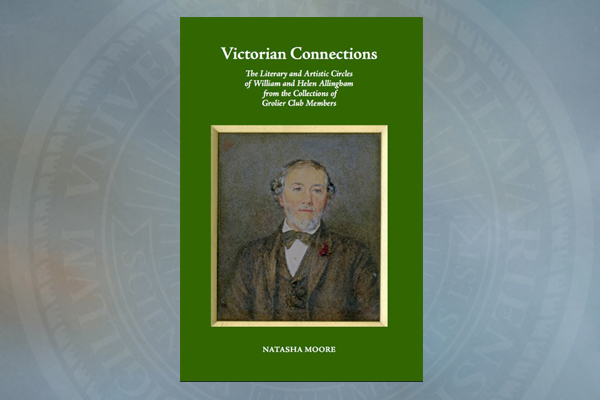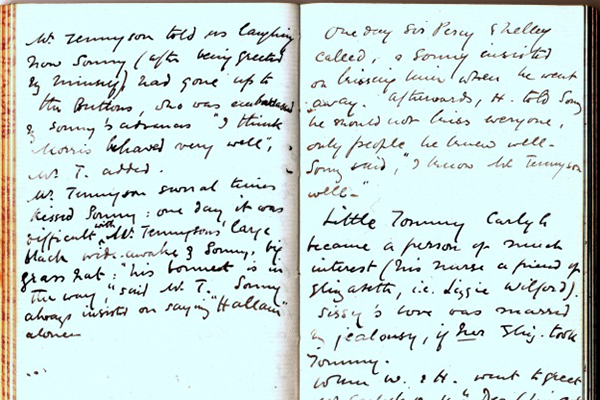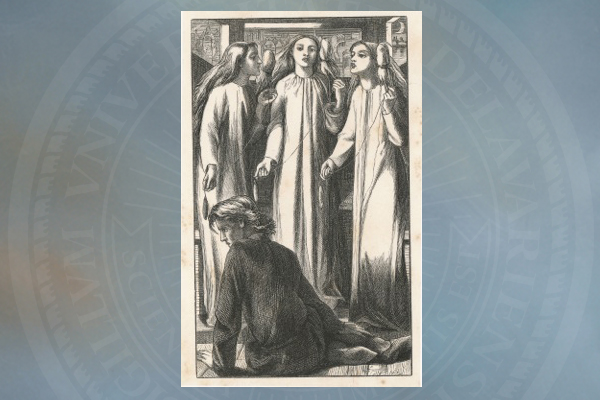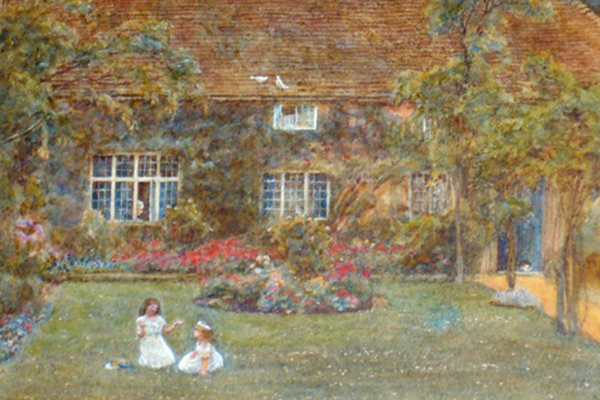


Victorian era exhibitions
University of Delaware and its Victorian connections highlighted
1:44 p.m., May 26, 2015--While William and Helen Allingham may not generate the same name recognition as many of their 19th century contemporaries, the Irish-born poet and his artist wife were connected to just about every literary and artistic luminary in the world of Victorian arts and letters.
The world of the Allinghams and their peers was the focus of the exhibition Victorian Connections: The Literary and Artistic Circles of William and Helen Allingham from the Collections of Grolier Club Members, which was on view through May 25 at the Grolier Club in New York City.
Campus Stories
From graduates, faculty
Doctoral hooding
Founded in 1884 and located in a classic brownstone on East 60th Street in New York City, the Grolier Club is America's oldest and largest society for bibliophiles and enthusiasts in the graphic arts. Named for Jean Grolier, the Renaissance collector renowned for sharing his library with friends, the club's objective is to foster "the literary study and promotion of the arts pertaining to the production of books."
The exhibition also has UD connections, including one of its co-curators, Natasha Moore, recipient of the 2014 University of Delaware Library/Delaware Art Museum Fellowship in Pre-Raphaelite Studies. The other co-curator is Mark Samuels Lasner, senior research fellow at the University of Delaware Library, and many of the more than 100 books, manuscripts, letters and works on art on display came from the Mark Samuels Lasner Collection, on loan to the University Library.
In the exhibition catalog published by the Grolier Club, Moore described William Allingham as an ambitious young poet from an out of the way town on the west coast of Ireland who became close friends with many Victorian notables, including Alfred Lord Tennyson, Thomas Carlyle and Dante Gabriel Rossetti and the Pre-Raphaelites.
A lifelong friend of fellow artists such as Kate Greenaway, a relative of Elizabeth Gaskell, Helen Patterson Allingham was an illustrator to novelists including Thomas Hardy, who was so impressed he wished to marry her, and went on to become famous for her delicate watercolors of the English countryside.
In recent years her watercolor paintings have enjoyed a renewed popularity, Moore noted.
During her residence in Delaware from Oct. 18 through Nov. 12, 2014, Moore enlisted the resources of the University of Delaware Library and the Delaware Art Museum to research unpublished materials relating to William Allingham’s life and to work to produce the first full-length critical study of this neglected but important literary figure.
Moore, who holds a doctorate in English literature from Cambridge University, is a research fellow at the Centre for Public Christianity in Sydney, Australia.
“This exhibition would not have happened if Natasha Moore had not come to UD,” said Samuels Lasner. “The Grolier Club had an open slot in its schedule and we made a proposal based on my collection, then found fabulous relevant materials in the collections of other members.”
Samuels Lasner’s favorite item in the exhibit is a 70-page manuscript notebook titled The Book of Sonny, written by William and Helen Allingham together. “It’s the typical baby book kept by proud parents, recording a child’s doing and sayings,” Samuels Lasner said. “But in this case the child is the Allinghams’ eldest son, Gerald, born in 1974, and the people he interacts with are George Elliott, Thomas Carlyle (Gerald’s godfather), Alfred Tennyson and Robert Barrett Browning. It’s quite a remarkable document and I’ve never seen another one quite like it.”
Another exhibition with a UD connection, “Everything is Going on Brilliantly: Oscar Wilde and Philadelphia,” was on view at the Rosenbach of the Free Library of Philadelphia through May 24.
The exhibit, co-curated by Samuels Lasner and Margaret D. Stetz, Mae and Robert Carter Professor of Women’s Studies and professor of humanities at UD, explored Wilde’s connections to the city and featured three newly discovered works by the 19th century Irish writer – a poetical notebook filled with drawings, a fragment of The Ballad of Reading Gaol and a corrected typescript of Salome – held by the Rare Book Department of the Free Library of Philadelphia.
Two galleries at the Rosenbach were decorated to resemble Aesthetic-movement drawing rooms, the kind where receptions were held by prominent Philadelphians to welcome Wilde. The first gallery focused on his two 1882 visits to Philadelphia to give lectures, as well as the side trips he made to Camden, New Jersey, to see Walt Whitman.
In the second room, visitors were able to see the many ways in which Philadelphia’s cultural life has continued to be influenced by Wilde and his works in terms of theatre, music and collecting.
This exhibition also featured documents related to a little known story – if Wilde had not come to Philadelphia he would never have written The Picture of Dorian Gray, for it was J.M. Stoddart, a publisher who served as his guide to the city, who later commissioned the novel that first appeared in Lippincott’s Magazine. The magazine was published in Philadelphia.
On June 12, Stetz and Samuels Lasner will give a joint lecture about the Wilde exhibition at Birkbeck College, University of London. Stetz also will deliver a lecture about the exhibition on June 15 at Trinity College, Oxford University.
“There is an extraordinary interest in British 19th century things, and the popularity of Downton Abbey, even though it is not strictly in the Victorian period, is an example of this interest,” Samuels Lasner said. “One of the Victorian novels Helen Allingham illustrated, Hardy’s Far From the Madding Crowd, has been made into a new film.”
“It doesn’t hurt that so many characters created by late Victorian authors are still popular in the public imagination,” Samuels Lasner said. “Think not only of Dorian Gray, but Dracula, Sherlock Holmes and Trilby. And J.M. Barrie began to sketch out Peter Pan years before the play was produced in 1904.”
He remarked that there is, in addition, growing interest by scholars in previously overlooked authors and artists, particularly women, of the period and in the areas of Victorian print culture and publishing history.
“These exhibitions represent collaborations that are unique to the University of Delaware – a collector and special collections curator was working with a professor of women and gender studies, as well as with a fellow in Pre-Raphaelite studies,” Samuels Lasner said. “And items from the Mark Samuels Lasner Collection and the University of Delaware Library were displayed in conjunction with materials from other collections at two important cultural institutions, the Grolier Club and the Rosenbach.”
He also noted that two graduate assistants in the Mark Samuels Lasner Collection, Petra Clark and Erin Brossa, both doctoral students in the Department of English, made important contributions to the exhibitions.
Article by Jerry Rhodes
Images courtesy of Mark Samuels Lasner











